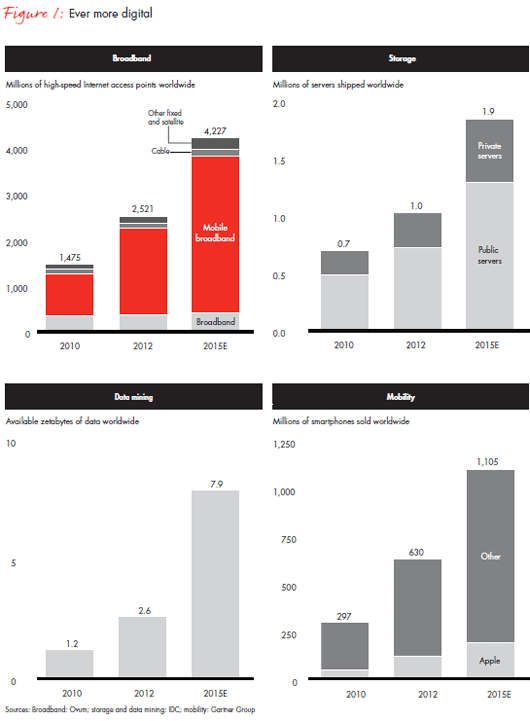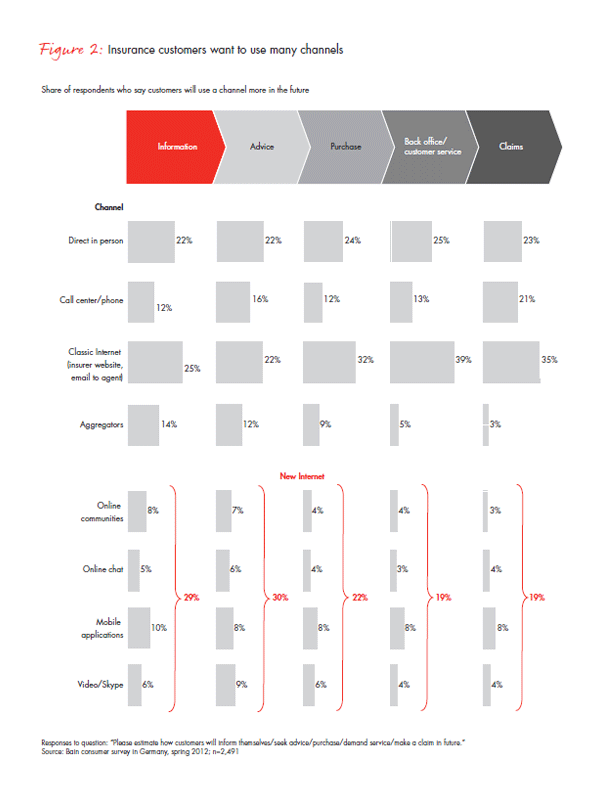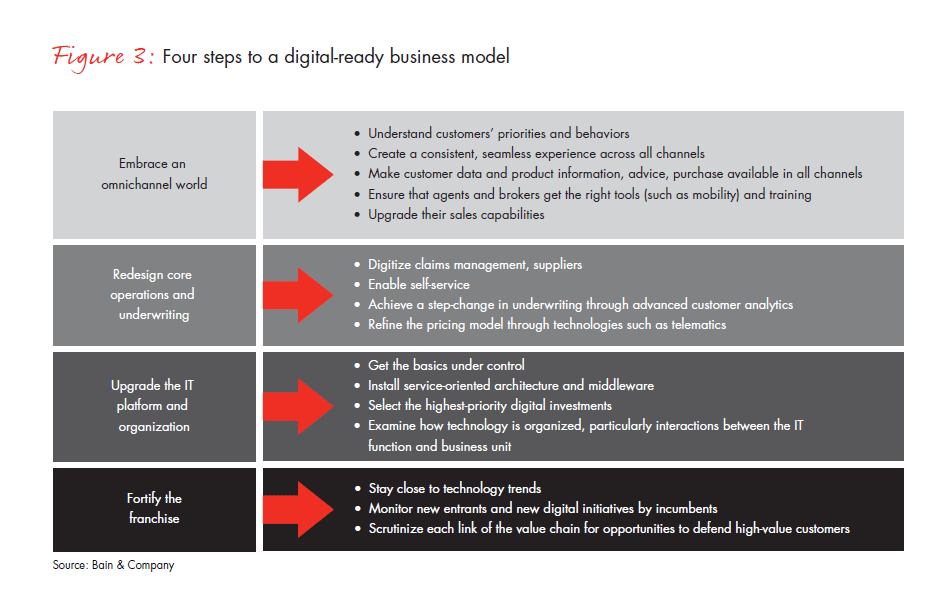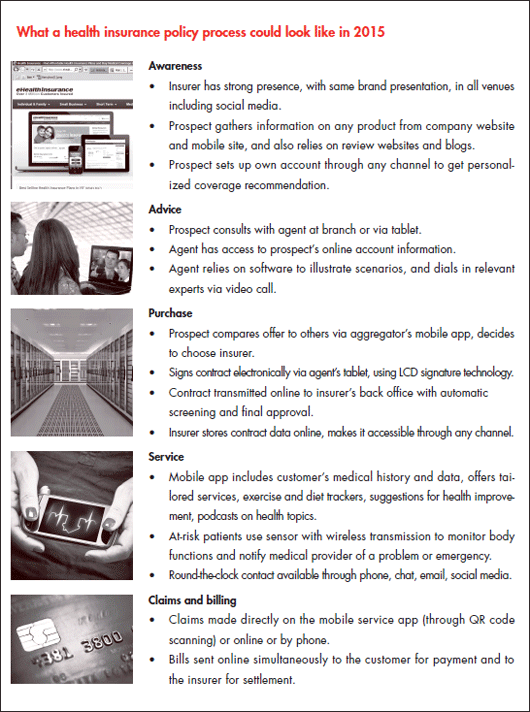Brief
Insurance companies across the world are rolling out a broad array of digital initiatives. These range from in-vehicle telematics that price driver risk better, to brand building on social media websites, to mobile applications that help agents create scenarios for prospective customers. Even in this conservative industry, a few forward-thinking players are experimenting with different business models for niche markets. And most executives recognize that they’re on the threshold of a once-in-a-generation opportunity to both reduce costs and foster new streams of profitable revenue growth.
It would be premature, however, to sing a hymn of praise to the industry’s digital conversion just yet. In most cases, insurers are pursuing a string of unconnected initiatives layered onto a legacy information technology (IT) system and a traditional mindset. Few of the insurance social media websites have attracted significant user attention or motivated consumers to buy. Meanwhile, upstarts have gained a foothold among technologically savvy customers seeking alternative, lower-cost models for simple products. And Web giants such as Google are testing the waters.
The digital disruption that has transformed sector after sector, from publishing to travel, has come to insurance. Many insurance executives view the digital challenge as purely an IT topic, a social media play or a onetime conversion that could be resolved in relatively short order.
It is none of these, but rather an ongoing challenge that involves all areas of the business and requires a significant shift in both capabilities and mindset—often leading to a fundamentally different business model for an insurer. Success in the digital arena requires a comprehensive approach that engages customers seamlessly across all channels—both online and off-line—and on their own terms.
Why is mastery of the digital space so pressing for insurers now? Mainly because the balance of power has been shifting to customers as a result of the rapid adoption of smart mobile devices, the ubiquity of broadband and the proliferation of social media and aggregator websites (see Figure 1). Consumers’ and businesses’ insurance needs remain largely the same as a decade or two ago, but their behaviors have changed radically: Customers now routinely use the Internet to inform, compare, buy and interact with providers.

Customers’ expectations, in short, now bridge online and physical worlds. Customers want to be able to use the channel convenient to the moment, whether that’s a website, call center or a video chat with a broker (see Figure 2). They expect insurance companies to anticipate their needs and involve them in devising tailored solutions. And they don’t hesitate to use social media to let others know how they were treated. Their advocacy cannot be dismissed: For one insurer in Hong Kong, for example, three-quarters of all new insurance purchases come via customer referral.

Besides suiting customer priorities, digital technologies offer potential efficiency gains at a time when many insurance lines have come under severe cost pressure. To some extent, the drive for efficiency continues a decades-long automation of paper-based activities. But some technologies like the cloud and big data are enabling new approaches in sales, underwriting and back-office operations; and still other technologies, such as mobile apps, enable personalized offerings and self-service capabilities that customers crave.
Addressing the digital challenge is a matter of survival, as insurance companies that act too late or stumble through the transition will lose customers and remain saddled with a relatively high cost base. Gartner estimates that by the end of 2015, personal lines property and casualty (P&C) insurers that do not offer online and mobile transactions will lose one-quarter of their current market share.1 A few first movers and even more fast followers, by contrast, will potentially gain stronger brands, customer relationships and cost positions. The winners will be able to tap new pools of revenue and raise profitability through more cross-selling, faster processes and lower-cost service.
Seizing the digital opportunity will require a deft touch and a concerted, ongoing effort in four strategic areas (see Figure 3): embracing an “omnichannel” approach; redesigning core operations and underwriting; upgrading the IT platform and organization; and fortifying the franchise. Let’s look at each in turn.

Embrace an omnichannel world
Omnichannel does not mean digital layered on top of, or to the side of, other channels. Rather, the key is to integrate disparate channels into a seamless experience (see below, “What a health insurance policy process could look like in 2015”). Bain introduced the omnichannel concept for the retail industry, where many traditional retailers have been decimated by the likes of Amazon.2 Success in retailing, indeed survival, hinges on designing digital and physical arenas that complement each other instead of substituting.
Integrating channels. In insurance, plenty of companies offer products through brokers, tied agents, banks and the Internet. Often, though, their pricing and service levels vary in each channel. Some insurers also have started to offer bits of information and advice through digital channels. Several auto insurers have mobile apps that allow customers to add a vehicle and get a quote, update a claim, pay bills and access an accident guide. US insurer Progressive offers an advice program via Twitter, and its website uses attractive offers and prepopulated application forms to stimulate cross-selling.
Only a handful of insurers, however, have begun to tie together their channels in a coherent, compelling fashion. One leader is a personal lines insurer that serves affinity customers worldwide and was a pioneer in digitizing claims to go paperless. For the past several years, this company, which we will call AffinityCo, has made a dedicated effort to capture customer information and make it available to anyone who touches the customer for any product, including call-center representatives, actuaries, claims adjusters and marketing staff—creating a 360-degree view of the customer. If a call-center rep hears a baby crying in the background, he or she will inquire about the baby and enter the information into the customer’s digital file, while also mentioning the possibility of upgrading a life insurance policy.
AffinityCo has introduced a variety of digital innovations, such as claims submissions through a mobile device or computer and tablet apps that allow adjusters in the field to update claims real time. Among its most startling innovations of late involves brick-and-mortar outlets. Based on customer feedback asking for in-person investment management, AffinityCo has been opening walk-in centers that focus on sales-oriented advice. A key goal is to cross-sell, as the company has learned that customers with more than two products have a higher propensity to remain loyal. At the same time, AffinityCo aims to achieve those sales by putting the customer first and solving his or her problems, rather than pursuing a sale at any cost.
Partly as a result of its nascent omnichannel approach, grounded in a deep understanding of customers’ priorities, AffinityCo is one of the fastest-growing P&C insurers in the world. And the company’s genuine empathy and support for customers have helped it earn customer loyalty scores that routinely rank at the top of the financial services sector.
Equipping staff. Developing an omnichannel approach will involve equipping tied agents and brokers with useful digital tools. One rapidly growing class of tools, called e-trade platforms, replaces the paper-based, labor-intensive system where a broker calls multiple underwriters for their quote on a policy, and then writes up each quotes separately; or where a broker has to navigate multiple IT systems of different insurers through different interfaces. Using e-trade, a broker offers the sales opportunity and insurers bid on it digitally, as in an auction, and the broker can use one interface for all the participating insurers.
Another promising class of tools, collaborative networks, digitizes the essential activity of discussing insurance deals, which goes back to Lloyd’s Coffee House in London during the late 1600s. Collaborative software for wholesale brokers allows them to search for industry news or sales materials, link to carriers at the point of a new or renewal opportunity and broaden their network—communication in a fraction of the time required in person or over the phone.
Going mobile. Mobility is the other digital feature that underpins an omnichannel approach, either for customer self-service or for upgraded sales and advice support for agents. On the first front, NTUC Income in Singapore offers a travel insurance app that enables customers to buy travel insurance all over the world, access an accident guide in case of accident, monitor flights and so on. On the latter front, life insurers, including Generali France and John Hancock have launched mobile apps on which agents can view customers’ investment portfolio details, fund performance and payment history. Other insurers are using mobile apps that generate animations and videos visualizing common risks of everyday life, with the goal of engaging customers in a more persuasive fashion.
Omnichannel strategies will inevitably encounter resistance from certain departments or employee groups, so insurance companies should anticipate and counter this tendency with appropriate tactics and incentives.
Consider what one pan-Asian insurer has been doing with its tied agents for whole life and similar savings products in several country markets. The company wants to challenge the notion that an agent needs five or six face-to-face meetings in order to close a sale. It has been equipping agents with app-loaded tablets to collect customer information and communicate with underwriters while in the field, thereby sharply reducing the turnaround time for issuing a policy.
But senior management doesn’t give away tablets to just any lackluster agent. To promote mobile uptake and usage, the company is targeting younger agents selecting opinion leaders who can sway other agents and linking use of the tablet to an incentive plan in which agents who hit their targets get reimbursed for the cost of the tablet. That appeals to agents’ competitive nature and reinforces the special value of the tablets.
Redesign core operations and underwriting
As insurers take advantage of the efficiencies afforded by digital technologies, it’s important to determine how the efficiency will improve or degrade the customer’s overall experience with the company. Done right, digital channels can provide greater convenience to customers. But customers also expect their carrier will look out for their interests, whether through fair pricing or problem resolution. As insurers deploy digital technologies, they should manage these expectations.
Enabling self-service. Insurers can make life more convenient for customers by enabling self-service in claims management. DKV in Germany offers a bar code scanning app that allows customers to instantly file and monitor the status of their medical bills issued by private healthcare clearinghouses. Further efficiencies will come from digitizing suppliers such as medical clinics and auto repair shops, with the customer’s information entered once and disseminated to all the relevant players.
Advancing analytics. In underwriting, insurers can use advanced customer analytics to lift performance and create competitive advantage. Almost all P&C insurers today have at least rudimentary analytical capabilities, but high-performing firms take a more expansive and ambitious approach.
A major US commercial insurance carrier, for instance, was dissatisfied with its approach to supermarket general liability risk, which masked the presence of good risks within broad segments such as “inner-city supermarkets.” So the carrier used analytical software to mine geographic data block by block and discovered a sub-segment of grocery stores that had a more attractive risk profile. This group of stores made more than one-third of its sales from fresh produce such as arugula and did not use drop-down security gates. Each store was located within two blocks of a health club and 24-hour parking garage. By targeting such stores with more favorable pricing and eliminating cross-subsidies, the carrier realized a four percentage point improvement in its combined ratio.
Analytics can improve the profitability of a carrier’s customer mix through an active strategy to avoid adverse selection by targeting high-profit potential customers with attractive pricing, and by repricing the existing book, driving the worst risks to competitors. Some carriers have begun to use in-vehicle telematics to vary premiums by driving behavior. A small digital device plugs into a car’s diagnostic port and communicates to the insurer actions such as sharp cornering and harsh acceleration. Telematics gather information about how and how much an individual drives, in order to accurately target discounts at careful drivers and charge more spirited drivers an appropriate higher premium.
Mining big data. Carriers can also take advantage of new digital data mining tools and new data sources such as postings on social networks and blogs (with some limits because of local privacy laws). Software is proliferating that can track mentions of a company or product, find relevant conversations and then be used to analyze volumes, locations or tones. While insurers have been slow to adopt these tools, some banks are mining such data to help predict customer churn and identify high-value customers.
Upgrade the IT platform and organization
The integrated, omnichannel approach will need a new technical and organizational spine so that insurers can deliver a seamless service experience to customers within a couple of years. Most large insurers operate with legacy IT architecture ill-suited to sharing or presenting data the same way on all channels. Gartner estimates that more than two-thirds of global life and P&C insurers still rely on legacy systems (some dating to the 1970s or ’80s) to a significant degree to manage their core processes. Recent experiences around the world suggest several principles that can guide efforts to upgrade the IT platform.
Getting the basics under control. First and foremost, make sure that the core system is stable and secure, doing what was promised and that the IT team is delivering projects on time and under budget. Customers are now accustomed to 99.9% levels of availability as they shop or transact online, yet some insurance companies are running at 98.5%, which can translate to interfaces with corporate clients being down for 45 minutes a day. CIOs and IT executives will have little credibility in the C-suite on strategic matters unless they deliver on the basics.
Deploying SOA and middleware. With the basics settled, most insurers should lay a foundation for their new system by installing service-oriented architecture (SOA) and middleware to extend an existing system, rather than replacing the core system all at once, which entails a once-in-generation investment and massive disruption. SOA defines how entities such as programs interact so one entity can perform work on behalf of the other. Middleware is software that lies between the operating system and applications, making it easier for software developers to overcome the rigidity of a legacy system. Further, data can be extracted from transaction systems and made available to anyone in the company.
Focusing on priorities. As part of a technology upgrade, IT and business teams should work together to select the highest-priority digital investments. The key questions are “What do we want to do, and how do we do it?” whether that is to produce quotes or increase cross-selling. Unless an insurer systematically looks across product lines, geographies and customer segments to pare down the wish list, it will not be prepared for negotiations with third-party providers and may be seduced by the latest shiny new offering.
Organizing effectively. Re-examining the organization of technology, including the relationship between the IT function and the business units, is another useful step. Many senior executive teams are frustrated by how long it takes to integrate new functionality into a legacy system, and by the excessive weight given to netpresent value calculations. Business units want IT staff to be more agile and flexible by, say, working with preconfigured solutions, delivering functionality in stages and demonstrating the features of “good enough” solutions at half the cost.
Thinking outside-in. Finally, an essential ingredient for the digital transition is to instill a culture that puts customer priorities front and center. This will mark a departure for many old-line insurers that have made decisions on matters like service levels from a strictly internal perspective, without checking first how the decisions will affect the customer.
Digital channels blended with the right amount of staff advice can renew customers’ trust. An example of this shift in the stock brokerage industry is highly analogous to whole life insurance, because both industries share an emphasis on advice, high broker churn, a heavy sales push of complex and expensive products and the strong desire among customers for greater self-service and self-education.
Samsung Securities of Korea went against the grain of conventional brokerage in its country, using digital channels to expand among younger, higher-income customers, who were wary of traditional brokers. With Samsung’s digital offering, called POP, customers self-select via a website decision tree into various segments, and then receive a set of advice options, each priced differently. They can still work with a personal adviser through phone, online chat or email, and the efficiency of the system allows advisers to manage up to 1,000 clients at a time. After two years, POP is already profitable.
Fortify the franchise
Insurers have long counted on regulation as a barrier to entry, but that and other barriers are crumbling. New models have emerged to threaten conventional insurers by offering greater speed, convenience and lower cost.
Aggregators such as BeatThatQuote in the UK, acquired by Google in 2011, compare product prices according to specific search criteria in vehicle insurance and standard small business risks. Other innovators use a crowdsourcing model, such as Friendsurance, enabling customers to gather in networks to provide one another with a first line of coverage.
Digital innovations today can ramp up and expand very quickly; consider that it took Google almost six years from 1997 to reach 50 million active users, but about 1.5 years for the iPad from 2010 and 0.3 years for Google+ since 2011. Insurers don’t want to be caught waiting too long in the face of incursions by innovators. Some of the most successful and fastest-growing insurers are small regional carriers that have been largely ignored by large multiline insurers.
Tracking technology trends. Insurers thus should put a system in place to monitor technology trends, especially among younger consumers, and track relevant innovations by small entrepreneurs or large players outside the industry. They should also scan for emerging substitutes from disruptive technologies. (For instance, what are the insurance implications of driverless cars that may be ready for sale within a few years?)
Defending high-value customers. Some incumbents are taking proactive measures in niche markets, as Assurant Solutions has done by launching Protect Your Bubble for gadget insurance. Most insurance companies, though, will benefit more from being fast followers of innovative models—with the emphasis on fast. They should also be scrutinizing each link of their value chain to erect defenses that reinforce their higher-profit-margin businesses and their grip on valuable customers, through measures such as introducing personal advice online.
Staging the digital transition
Integrating the digital and physical worlds is not a straightforward process. And doing it all at once would be enormously expensive and complex, so most insurers should proceed in phases.
To form a clear-eyed view on where and how to start, insurers can undertake a detailed initial assessment that answers several key questions:
- Where is the current business model under greatest pressure?
- Which digital trends are most urgent for protection, which for seizing opportunities and which can bear watching?
- What is the scale of the implied effort?
- Which areas do target customers most value, and therefore deserve investment?
Taking stock through an assessment will help senior executives understand the point of departure, their overall ambition and what it will take to deliver results. All disciplines should be involved, not just IT, and all potential initiatives should be screened from the perspective of their impact on the customer’s experience. In this conservative industry, companies that are willing to move quickly and take calculated risks stand to gain a competitive advantage over more sluggish rivals.
Bain & Company partner Henrik Naujoks, principal Bodo von Huelsen, partner Gunther Schwarz and partner Stephen Phillips are members of the firm’s Global Financial Services practice. They are based, respectively, in Düsseldorf, Frankfurt, Düsseldorf and London.


